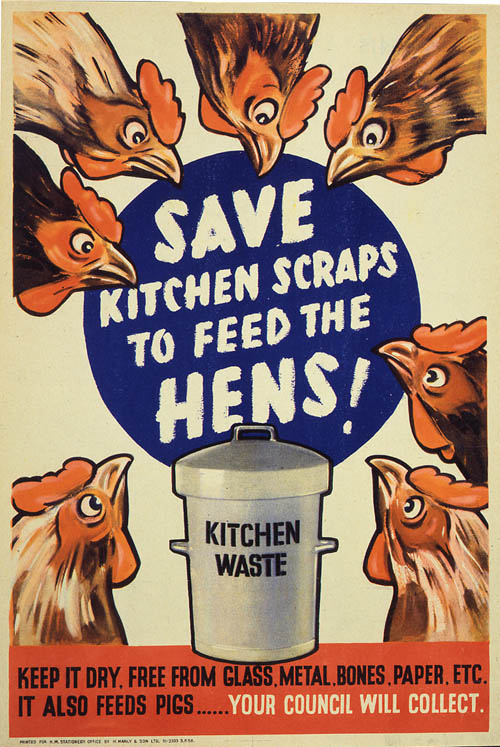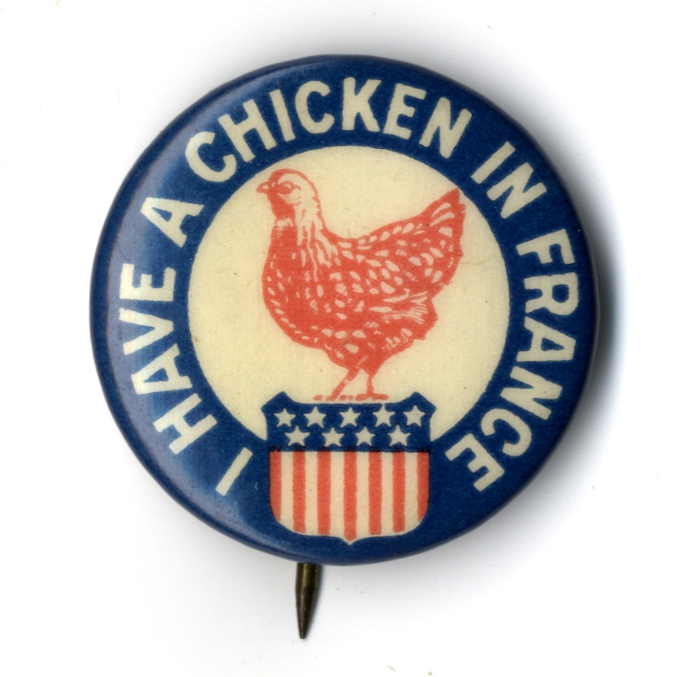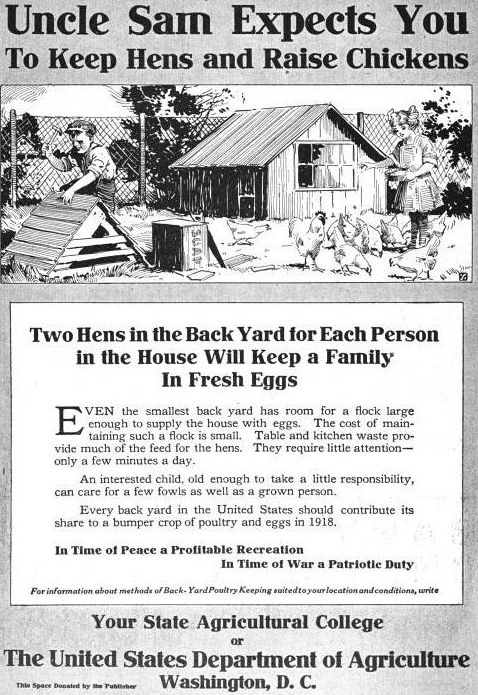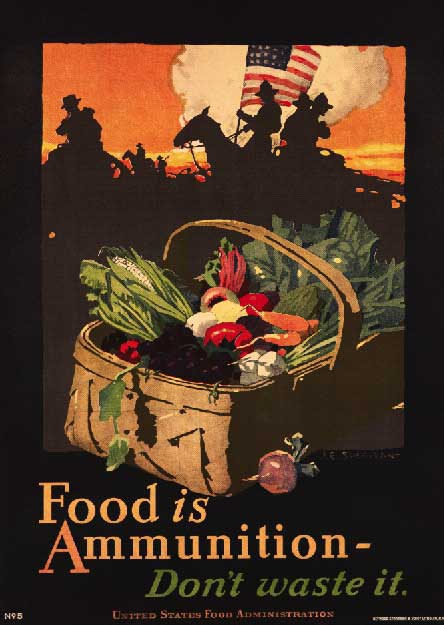Bawk to the future: How backyard chicken keeping began as a war effort
By: Susanne Harm
|
Today’s backyard chickens are pampered pets… especially when compared to my Grandma’s hens. My Gram raised chickens out of necessity to feed her family. Raising chickens was about not going hungry. Gram’s chickens did not have names. My hens, a.k.a. The First Ladies, do. In a relatively short time, America has gone from chickens as sustenance to chickens as feathered, backyard pets with benefits (eggs, insect control and free fertilizer). But where did the original idea of having hens in our backyards come from? Recently, a coworker gave me this vintage war poster featuring, you guessed it, hungry hens. That poster inspired me to do some research on the history of backyard chickening. It’s a fascinating story and an important lesson on how food production and conservation helped win wars. |
 |
Chickens During World War I
In the early 1900s, American chickens were not considered necessary “livestock” animals on farms. Chicken meat was a delicacy, only served on special occasions and eggs were a luxury. Small flocks of chickens were only raised on rural family farms. Families with larger flocks (300 or more) sold eggs as their primary income.
Meanwhile Europe was in the middle of the ugliest, bloodiest war the world had ever seen. World War I, called The Great War by people who didn’t know there would be a second Great War only two decades later. Initially the United States remained neutral but Germany’s increased aggression towards the United States resulted in President Woodrow Wilson entering World War I on April 6, 1917.
Rechickenize France!
|
Before the United States officially entered WWI, support was already being sent overseas. When Belgium and France ran out of food, and famine was threatening both countries, one of the many programs from the United States War Relief Service supported the plan to “rechickenize” France. During WWI, France ran out of fresh food, including chickens. In response, the Daughters of the American Revolution launched a fundraising campaign to “rechickenize” the country. Those who contributed were given a pin. “Every dime given means an egg, every quarter means a chicken,” wrote Mrs. William Henry Wait, of the society’s War Relief Service Committee. |
 |
Uncle Sam
|
After entering WWI, a 1918 government poster declared: “Uncle Sam Expects You To Keep Hens and Raise Chickens.” This USDA poster simultaneously addresses personal food security, childhood responsibility, recreation, income potential and patriotic duty all with a simple appeal for backyard chickens. By 1918, America’s backyard chickens were superstars for the war effort. They foraged for their own food, turned kitchen scraps into nitrogen-rich compost, removed harmful garden insects, tilled the soil for crops and gave back fresh, healthy eggs. Suburban chickens were also revenue earners when there were extra eggs to sell. By producing their own crops and raising chickens, families were allowing more food supplies to be made available for our troops in Europe. This was a critical strategy since the U.S. was also contributing food to our allies who were in many cases, literally starving. |
 |
Chickens During World War II
War between the United States, Germany and Japan was declared following the attack on Pearl Harbor in December 1941. Again, food, especially meat, was rationed and there was a new, even stronger effort to attract all Americans to backyard gardening and chicken keeping.
Victory Gardens
|
To reduce pressure on the public food supply, everyone who had any land was encouraged to grow a victory garden. Besides indirectly aiding the war effort, these gardens were considered a civil "morale booster" since gardeners could feel empowered by their contribution of labor and rewarded with fresh produce. This made victory gardens a part of daily life on the home front and led to nationwide increases in backyard flocks. By May 1943, there were 18 million victory gardens in the United States—12 million in cities and 6 million on farms. The US Government encouraged families to embrace gardening, chicken keeping and canning to reduce demand on national supplies needed for the war effort |
 |
Chickens After World War II
When World War II ended in 1945, the government stopped promoting victory gardens. The majority of Americans didn’t plant a garden in the spring of 1946, and the demise of backyard chicken keeping and food production began. There was also a huge change in the way food was produced. Chickens slowly began to be raised in great numbers, improvements in production capabilities and lower labor costs meant the price of eggs plummeted and many family-owned chicken farms went bankrupt.
Supermarkets replaced corner butcher shops, and many people traded farm life for suburbia. The sprawl of the suburbs pushed the farmlands farther away from cities, separating farms from our tables. Growers continued to raise more birds, started to mix antibiotics and growth hormones into the feed and refrigeration systems allowed meat to be transported hundreds or thousands of miles.
Chickens Today
The 1900s saw the beginning of a second movement towards self-sustainability, organic farming and backyard chicken keeping.
Today, raising suburban chickens is a growing trend, especially in Austin. Although I originally adopted my hens as a way to control grasshoppers, they’ve since become more than just garden helpers and egg producers. My fun, free-range, backyard pets have swings, treats and cedar wood nesting-box curls. The only other difference between my girls and my Gram’s is that the First Ladies all have names.
